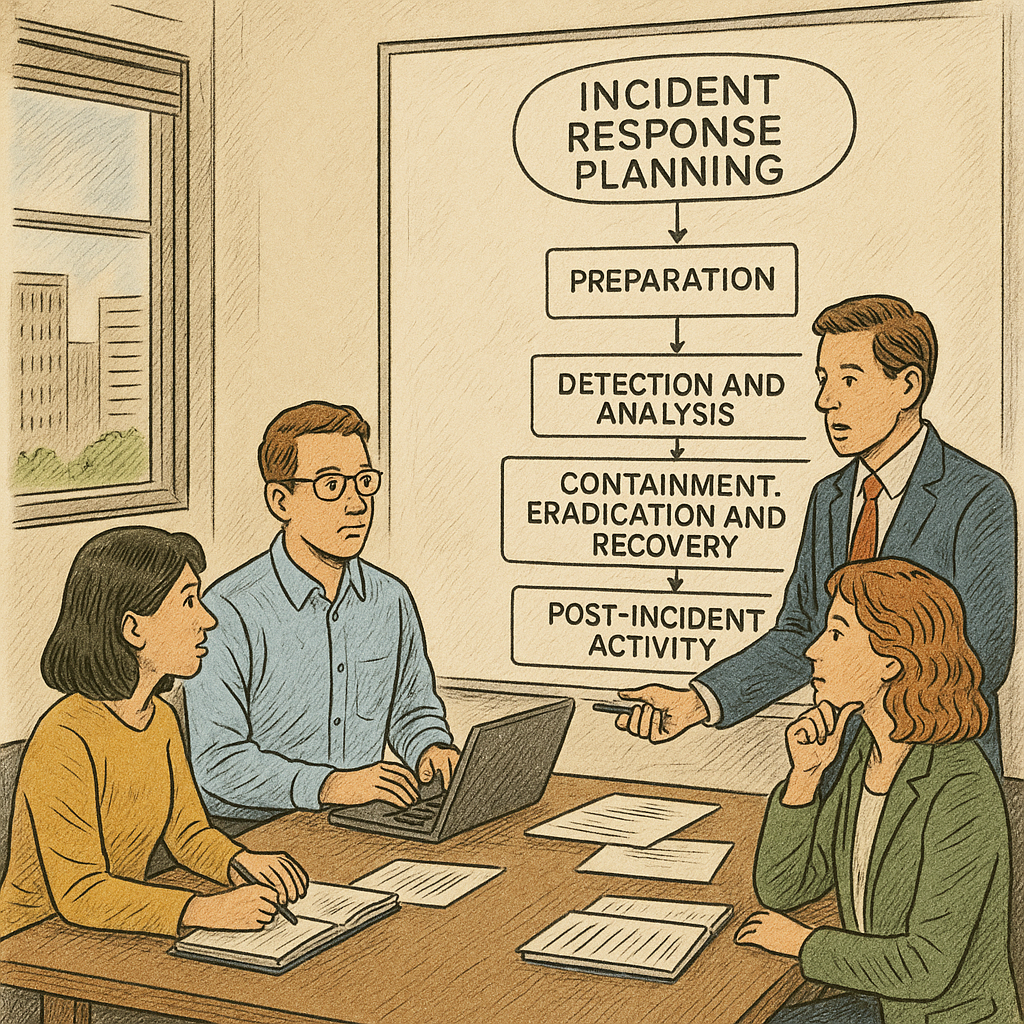
PowerShell - Detecting Attacks
Cybersecurity incidents aren't a question of if, but when. In today's hyper-connected world, incident response planning is essential—not just for protecting systems, but also for minimizing damage, restoring trust, and ensuring business continuity.
An Incident Response Plan (IRP) is a structured approach for managing and mitigating security incidents. It ensures your organization is ready to detect, respond to, and recover from cyber threats.
Without a well-defined IRP, even minor incidents can spiral into major crises—bringing operations to a halt, damaging reputations, and incurring significant financial losses.
Data breaches and ransomware attacks are no longer rare. In fact:
These stats underscore the importance of a proactive response plan tailored to modern threats.
An IRP is a documented strategy outlining:
The primary goal is to limit the damage, restore normal operations, and prevent recurrence.
| Component | Description |
|---|---|
| People | Defined roles within the Incident Response Team (IRT) |
| Processes | Step-by-step procedures for each incident phase |
| Technology | Tools like SIEMs, EDR, log analyzers, and ticketing systems |
| Communication Plan | Internal alerts and external notifications (including media and regulators) |
| Compliance & Reporting | Documentation to satisfy legal, regulatory, and policy requirements |
| # | Phase | Actions / Steps |
|---|---|---|
| 1. | Preparation | * Drafting policies and playbooks |
| * Setting up logging and alerting systems | ||
| * Training team members and end-users | ||
| 2. | Identification | * Monitoring systems |
| * Detecting signs of compromise using tools (SIEM, IDS, log analysis) | ||
| 3. | Containment | * Isolating affected systems |
| * Preventing spread to other parts of the network | ||
| 4. | Eradication | * Removing malware |
| * Closing exploited vulnerabilities | ||
| 5. | Recovery | * Restoring systems from backups |
| * Validating system integrity | ||
| 6. | Lessons Learned | * Conducting a post-mortem |
| * Updating the IRP and security controls |
"Failing to prepare is preparing to fail."
Key steps:
Timely identification is the key to minimizing damage.
Use:
Red flags may include:
There are two types of containment:
Avoid deleting or altering evidence that may be needed for forensics.
Once contained:
This phase focuses on eliminating the root cause of the breach.
Ensure systems are clean before bringing them back online.
Steps include:
This phase also ensures that services return safely and reliably.
Learning from incidents is key to improving future response.
| Role | Responsibility |
|---|---|
| Incident Commander | Oversees the entire response effort |
| Security Analyst | Investigates the incident, collects evidence |
| IT Support | Aids in containment and recovery |
| Legal & Compliance | Ensures the response meets regulatory requirements |
| Communications Officer | Handles press and public disclosures |
When a mid-sized financial firm discovered unusual outbound traffic on its network late one Friday evening, its cybersecurity team quickly initiated its incident response plan. Within minutes, the team identified the affected systems and determined that a phishing email had tricked an employee into revealing credentials. The IT department moved swiftly to isolate compromised machines, block malicious IP addresses, and reset credentials across the organization. Over the weekend, forensic specialists combed through logs to assess the breach's scope, ensuring no customer data had been exfiltrated. By Monday morning, the company had restored normal operations, issued an internal report detailing the event, and began employee training sessions to prevent similar incidents.
Cyberattacks are inevitable, but disaster is not—if you're prepared. A comprehensive Incident Response Plan can make the difference between a minor disruption and a major catastrophe. Start small, iterate often, and involve your entire organization.

To detect, manage, and recover from incidents while minimizing damage and downtime.
Security staff, IT personnel, legal advisors, and communications officers.
At least twice a year using table-top or live simulation exercises.
SIEM, EDR, forensics software, and secure communication channels.
No. Every business, regardless of size, should have an incident response plan.
If there's criminal activity, data theft, or compliance risk—yes. Follow your legal team's guidance.
Preparing for a cyber attack is crucial for any organization or individual in today's digital landscape. While no single set of steps can guarantee complete immunity, implementing a comprehensive cybersecurity strategy significantly reduces risks and minimizes potential damage.
Identify and prioritize your critical assets (data, systems, applications), assess potential vulnerabilities, and understand the threats most relevant to your organization. This forms the foundation of your cybersecurity strategy.
Deploy essential security tools such as firewalls, intrusion detection/prevention systems (IDS/IPS), antivirus software, and encryption for sensitive data. Ensure secure configuration standards are applied to all systems, networks, and applications.
Create a detailed plan outlining procedures for detecting, analyzing, containing, eradicating, and recovering from cyber incidents. Regularly test this plan through simulations and tabletop exercises to ensure its effectiveness and refine it as needed.
Keep all software, operating systems, and applications consistently updated. Cybercriminals often exploit known vulnerabilities, and timely patching is a critical defense mechanism. Implement a system for automated patch management where possible.
Enforce the principle of least privilege, ensuring users only have access to the resources absolutely necessary for their role. Implement MFA for all accounts, especially those with privileged access, to add an extra layer of security beyond just passwords.
Human error is a significant factor in many breaches. Educate all employees about common cyber threats (like phishing, social engineering), secure computing practices, and how to report suspicious activity. Regular training and simulated phishing exercises are essential.
Implement a robust data backup strategy, adhering to the 3-2-1 rule (three copies of data, on two different media, with one copy offsite). Regularly test your backup and recovery procedures to ensure you can quickly restore critical data in the event of a successful attack.
Enforce the use of long, complex, and unique passwords for all accounts. Encourage or mandate the use of password managers to help employees create and store strong credentials securely.
Implement continuous monitoring of network activity and system logs to detect unusual patterns, suspicious behavior, or potential intrusions in real-time. This includes using Security Information and Event Management (SIEM) systems.
Assess the cybersecurity posture of your vendors and third-party service providers who have access to your systems or data. Incorporate security requirements into contracts and continuously monitor their adherence to those standards.
By proactively addressing these steps, organizations can significantly enhance their resilience against cyber attacks and be better prepared to respond effectively when incidents occur.
What steps do you find most challenging to implement in your own organization?